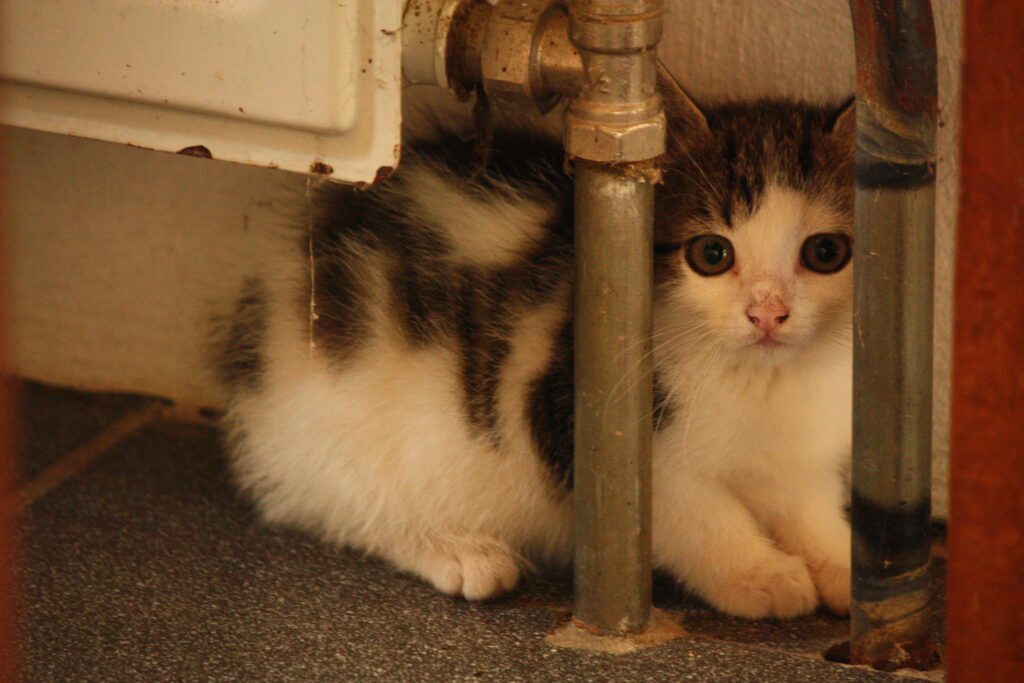Help an abused cat re-socialize and recover from trauma by providing them with a safe, secure, and nurturing environment.
This should include regular exercise, mental stimulation, and plenty of socialization opportunities with humans and other animals.
It’s important to give them plenty of time to adjust to their new living conditions while offering gentle yet consistent reinforcement for positive behaviors.
- Key Takeaway
- Is It Possible To Regain a Cat’s Trust?
- How To Help an Abused Cat Re-Socialize and Recover
- How Long Does It Take For An Abused Cat To Trust You?
- How Do You Regain An Abused Cat’s Trust?
- FAQs
- Q: What does it mean for a cat to be abused?
- Q: How can I help an abused cat recover?
- Q: What are some signs that a cat has been abused?
- Q: Can an abused cat ever trust humans again?
- Q: Should I force the cat to interact with me?
- Q: How can I make a scared cat feel safe?
- Q: How long does it take for an abused cat to recover?
- Q: What if my cat refuses to use the litter box?
- Q: Can I adopt a formerly abused cat?
- Q: How should I introduce a new cat to an abused cat?
- In Conclusion
Key Takeaway
- Helping an abused cat re-socialize and recover involves providing a safe space, maintaining a quiet and calm environment, spending time together without forcing interaction, avoiding direct eye contact, using a soft, reassuring tone of voice, and allowing the cat time to heal and gradually build trust.
Is It Possible To Regain a Cat’s Trust?

Yes, it is possible to regain a cat’s trust. This process, however, requires patience, understanding, and consistency.
Begin by creating a calm and secure environment for the cat, as this can help reduce their anxiety.
Consistency in your daily routines such as feeding times or play sessions can also be reassuring for them.
It is important to respect their space and allow them to initiate interactions. Using treats or their favorite toys can be helpful in creating positive associations with you.
Over time, through gentle care and patience, you can rebuild trust with a cat.
How To Help an Abused Cat Re-Socialize and Recover

- Step 1: Provide a Safe Environment
- Step 2: Maintain a Regular Routine
- Step 3: Gradual Introduction to New Things
- Step 4: Use Positive Reinforcement
- Step 5: Encourage Play
- Step 6: Seek Professional Help
- Step 7: Be Patient and Consistent
Step 1: Provide a Safe Environment
The first step in helping an abused cat recover is to provide them with a safe, calm and quiet environment. This could be a small room in your home that’s free from loud noises and other pets. Furnish it with a comfortable bed, food, water, and a litter box.
Step 2: Maintain a Regular Routine
Cats thrive on routine. Create a regular feeding, playing, and sleeping schedule for the cat. This will help them feel secure and understand what to expect at different times of the day.
Step 3: Gradual Introduction to New Things
Introduce new things slowly, whether it’s people, other pets, or new spaces in your home. Any sudden changes can cause stress and fear.
Step 4: Use Positive Reinforcement
Reward good behavior with treats, praise, or petting (if the cat is comfortable with touch). Never use punishment as it can trigger fear and anxiety, hindering their progress.
Step 5: Encourage Play
Engage the cat in play using toys. This helps build trust and confidence, while also providing physical exercise and mental stimulation.
Step 6: Seek Professional Help
If your cat continues to show signs of fear or aggression, consider seeking the help of a professional animal behaviorist or a veterinarian. They can provide guidance and potentially recommend medication if necessary.
Step 7: Be Patient and Consistent
Recovery and re-socialization take time. Be patient, consistent, and loving. Celebrate small victories and remember that progress may be slow, but any progress is a step in the right direction.
How Long Does It Take For An Abused Cat To Trust You?
The time it takes for an abused cat to trust you can range from a few days to several months or even years, depending on the cat’s personality, the severity of the abuse they’ve suffered, and the consistency and quality of care they’re given.
It is important to provide a safe space for the cat, maintain a routine, minimize noise and other stressors, and use positive reinforcement such as treats and toys.
Gradually spending time together and allowing the cat to approach you at their own pace can also help build trust.
How Do You Regain An Abused Cat’s Trust?
Regaining an abused cat’s trust requires patience, consistency, and a gentle approach. Start by providing a safe and quiet environment for the cat to feel secure.
Maintain a regular routine for feeding, playtime, and rest, as predictability can help the cat feel more in control.
Introduce new experiences, people, or pets slowly and gradually to avoid overwhelming the cat. Use positive reinforcement like treats or praise to reward good behavior.
Encourage play with toys to build confidence and trust. Always respect the cat’s boundaries and never force interaction.
Remember, recovery takes time and every cat will progress at their own pace. It’s important to be patient and celebrate small victories along the way.
FAQs
Q: What does it mean for a cat to be abused?
A: When we say a cat has been abused, it means that the cat has been subjected to some form of physical or emotional harm by humans.
Q: How can I help an abused cat recover?
A: Helping an abused cat recover involves providing a safe and nurturing environment, gaining the cat’s trust, and allowing them to rebuild their confidence at their own pace.
Q: What are some signs that a cat has been abused?
A: Signs that a cat has been abused may include fear and aggression towards humans, avoidance behavior, flinching or cowering when approached, and physical injuries.
Q: Can an abused cat ever trust humans again?
A: Yes, with patience, love, and consistent care, most abused cats can learn to trust humans again. However, it may take time and may vary depending on the severity of the abuse.
Q: Should I force the cat to interact with me?
A: No, it is important never to force an abused cat to interact with you. Let the cat approach you on their own terms and at their own pace.
Q: How can I make a scared cat feel safe?
A: Creating a safe and secure environment for a scared cat involves providing hiding spots, ensuring they have access to food and water, and minimizing loud noises and sudden movements.
Q: How long does it take for an abused cat to recover?
A: The recovery process for an abused cat can vary. Some cats may show improvement within weeks, while others may take months or even longer to fully recover.
Q: What if my cat refuses to use the litter box?
A: If your cat refuses to use the litter box, it may be due to anxiety or past trauma. Consult with a veterinarian or a feline behavior specialist to address any underlying issues and find solutions.
Q: Can I adopt a formerly abused cat?
A: Yes, many formerly abused cats can make loving and loyal companions. However, it is important to understand their specific needs and be prepared to provide the necessary care and patience.
Q: How should I introduce a new cat to an abused cat?
A: When introducing a new cat to an abused cat, it is crucial to do so gradually and in a controlled environment. Allow the cats to get used to each other’s scent before any direct interactions.
In Conclusion
Ultimately, re-socializing and recovering from abuse in cats is an extremely difficult process that requires dedication and patience.
A cat may never fully recover if the trauma was severe enough.
However, with the right help and support, cats can move on to new homes or environments where they can live happily and peacefully for the rest of their lives.





Leave a Reply